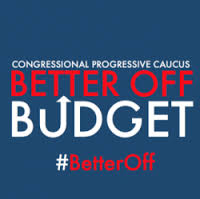Each year the Congressional Progressive Caucus releases its own budget, but even with 74 members – the biggest Democratic caucus – it is completely ignored by the media.
Its role is to provide a more visionary alternative to President Obama’s budget and a challenge to the Republican version – which does get plenty of air time (due out soon).
This year’s budget again challenges the austerity mindset that dominates the House, which stokes inequality by cutting crucial federal programs to the bone while refusing to invest in infrastructure that would create millions of jobs.

It "reverses harmful cuts that have hit working families the hardest – starting with repealing across-the-board budget cuts known as the Sequester. It creates a fairer tax code so that low and middle-income families no longer pay more than they should while the world’s biggest corporations benefit from unnecessary loopholes. Our budget reverses harmful pay freezes, expands benefits for federal retirees and strengthens federal health care and retirement programs Americans rely on," state co-Chairs Reps. Raúl Grijalva (D-AZ) and Keith Ellison (D-MN).
Developed with the Economic Policy Institute, it makes jobs the #1 priority, creating 8.8 million by 2017, and even though it increases spending over the next 10 years by $2.5 trillion, it still cuts the deficit by $4.08 trillion during that time – more than either the White House or last year’s Republican budget led by Rep. Paul Ryan (R-WI).
The Progressive Caucus has consistently produced budgets that balance significant deficit reduction with substantial near term investments that create jobs, strengthen the safety net, and reduce inequality, according to Institute for Policy Studies analyses.
Highlights of the 2015 "Better Off Budget":
- Climate Change: eliminates $118 billion in fossil fuel subsidies by 2024; implements a carbon tax that strengthens the market for clean energy and transportation; invests in renewable energy;
- Tax Code: closes loopholes to prevent corporations from evading taxes; adds a small tax on financial speculation (which 30 countries have); a new Hard Work Tax Credit for households that earn under $150,000; Clinton-era taxes on the highest incomes and a new bracket for incomes over $1 million;
- Health Care: improves on the Affordable Care Act by adding a public option and allowing states to opt for single-payer;
- Military: shrinks the War budget (separate from the Defense budget) from its bloated size, doubled since 2001
- Employment: expansive infrastructure re-build; gives states assistance to re-hire police, firefighters, teachers and other public employees; training and employment services that match skills with employer demand; ends federal pay freezes;
- Safety Net: Increases Social Security benefits by scrapping the cap, restores the full Food Stamp program and unemployment insurance
- Elections: funded publicly
The budget achieves its goals of restoring the economy and jobs by going after "wasteful areas" that legislators won’t touch, such as the Defense’s war budget, tax havens for the rich, and oil company subsidies.
It generates revenue by ending the disparity between taxes on income versus dividends and capital gains, eliminating corporate loopholes, and by imposing a carbon tax that also helps lower-income families.
Here’s the long discussion of the budget and a summary:
